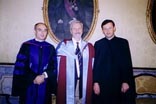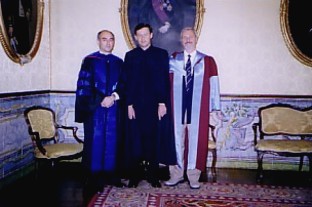PhD Thesis at University of Coimbra
 The PhD examination of Paulo Fernando Antunes dos Santos took place at the University of Coimbra in Portugal. The topic was the Solution of Wave Propagation Problems using Boundary Elements and it was supervised by Professor Antonio Tadeu from the Faculty of Civil Engineering of that University, who is also a Member of the Board of Directors of the Wessex Institute of Technology. The Examination Board consisted of three Professors from Coimbra, one from the University of Minho, another from the University of Porto and Professor Carlos Brebbia, Director of WIT.
The PhD examination of Paulo Fernando Antunes dos Santos took place at the University of Coimbra in Portugal. The topic was the Solution of Wave Propagation Problems using Boundary Elements and it was supervised by Professor Antonio Tadeu from the Faculty of Civil Engineering of that University, who is also a Member of the Board of Directors of the Wessex Institute of Technology. The Examination Board consisted of three Professors from Coimbra, one from the University of Minho, another from the University of Porto and Professor Carlos Brebbia, Director of WIT.
Coimbra is the oldest University in Portugal and was founded in the XIII Century. The examination took place in the ancient University Campus, in the Sala dos Capelos (Gown Hall) dating from the XVII Century where PhD theses are usually presented. The examiners, seated in a raised gallery, conduct a detailed examination of the candidate, who sits below them. The Hall has a polygonal roof with painted panels and portraits of Portuguese kings along the walls which are also nicely decorated with beautiful tiles (azulejos), one of the most outstanding crafts of Portugal.
The examination of Paulo Santos’ thesis took place amidst this splendour. His thesis dealt with the study of wave propagation problems in solids and fluids, using BEM. The work is of great importance in a wide range of applications, including seismic and acoustics analysis. In the latter cases for instance, the acoustic modelling of fluid-structure interaction is key to the understanding of the process. BEM is the best-suited method for this problem, because it allows the far field boundary conditions to be satisfied automatically and does not require the internal discretisation of the domain involved. Similar arguments make BEM the best method for modelling soils and different types of foundations.
The applications of Paulo Santos covered the development of BEM as a method of modelling wave propagation in solid and fluid media, for problems involving two-dimensional geometries and harmonic varying point loads. These problems are usually referred to as 2.5 dimensional.
The problem has been formulated in the frequency domain, where the point sources are described as a summation of linear sources with sinusoidal variation along the discretion where the geometry is constant. The response in the time domain are obtained by fast Fourier transform, using complex frequencies.
The potential of the different numerical algorithms developed has been demonstrated in the resolution of a number of problems. One of them involves the study of the insulation provided against air borne sound by a single wall, or by an acoustic barrier separating two confined acoustic spaces. Another set of applications consists of modelling the waves propagating in the vicinity of seismic prospecting boreholes. Finally the models are applied to simulation seismic response generated in the vicinity of an elastic half-space surface, when the surface is irregular or an inclusion or tunnel is present in the elastic medium.
Paulo Santos underwent a gruelling three hour examination, during which he responded well to the questions posed by the Jury. They wanted to know further details of the work, ranging from mathematical developments to practical applications.
Paulo’s work is of importance for the analysis of the type of vibrations and noise generated in urban areas by railways and road constructions, particularly tunnels or cuts in the proximity of buildings. Levels of vibration in the range of up to 100HZ are particularly disturbing for building inhabitants. A major source of this noise is railway trains passing through urban areas. The proper design of the buildings in their proximity, can substantially improve lack of comfort when using techniques such as base insulation, and acoustic screens.
The work reported by Paulo can be applied to finding the dynamic stiffness of foundations as well as the acoustic pressure waves produced by the vibrations. The resulting matrices can be combined with the structural and acoustic matrices for the building, which can be obtained through finite element models or a combination of those with boundary elements. The main limitations relate to the large number of elements required to run a practical problem, although they could be reduced using techniques such as half-space Green’s functions or some form of higher element formulation. This is a subject of future research, among others suggested by Carlos.
Paulo’s thesis makes an important contribution in a difficult field of research and points the way to further investigations. He was congratulated by the Examiners on his performance and the quality of his thesis.


 Wessex Institute
Wessex Institute